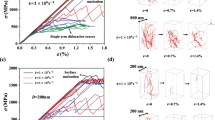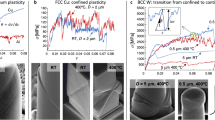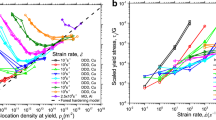Abstract
A quantitative description of plastic deformation in crystalline solids requires a knowledge of how an assembly of dislocations — the defects responsible for crystal plasticity — evolves under stress1. In this context, molecular-dynamics simulations have been used to elucidate interatomic processes on microscopic (∼10−10 m) scales2, whereas ‘dislocation-dynamics’ simulations have explored the long-range elastic interactions between dislocations on mesoscopic (∼10−6 m) scales3. But a quantitative connection between interatomic processes and behaviour on mesoscopic scales has hitherto been lacking. Here we show how such a connection can be made using large-scale (100 million atoms) molecular-dynamics simulations to establish the local rules for mesoscopic simulations of interacting dislocations. In our molecular-dynamics simulations, we observe directly the formation and subsequent destruction of a junction (a Lomer–Cottrell lock) between two dislocations in the plastic zone near a crack tip: the formation of such junctions is an essential process in plastic deformation, as they act as an obstacle to dislocation motion. The force required to destroy this junction is then used to formulate the critical condition for junction destruction in a dislocation-dynamics simulation, the results of which compare well with previous deformation experiments4.
This is a preview of subscription content, access via your institution
Access options
Subscribe to this journal
Receive 51 print issues and online access
$199.00 per year
only $3.90 per issue
Buy this article
- Purchase on Springer Link
- Instant access to full article PDF
Prices may be subject to local taxes which are calculated during checkout



Similar content being viewed by others
References
Friedel, J. Dislocations(Pergamon, Oxford, (1964)).
Abraham, F. F. et al. Instability dynamics in three-dimensional fracture: an atomistic approach. J. Mech. Phys. Solids 45, 1461–1471 (1997).
Devincre, B. & Kubin, L. P. Mesoscopic simulations of dislocations and plasticity Mater. Sci. Eng. A234–236, 8–14 (1997).
Devincre, B. & Kubin, L. Simulations of forest interactions and strain hardening in FCC crystals. Modelling Simul. Mater. Sci. Eng. 2, 559–570 (1994).
Abraham, F. F. On the transition from brittle to plastic failure in breaking a nanocrystal under tension. Europhys. Lett. 38, 103–106 (1997).
Hirth, J. P. & Lothe, J. Theory of Dislocations 2nd edn 792–806 (Wiley, New York, (1982)).
Nabarro, F. R. N. Theory of Crystal Dislocations (Oxford Univ. Press, London, (1967)).
Prinz, F. & Argon, A. S. Dislocation cell formation during plastic deformation of copper single crystals. Phys. Status Solidi A 57, 741–753 (1980).
Korner, A. & Karnthaler, H. P. Weak-beam studies of composite dislocations gliding on (001) planes in Si. Phil. Mag. 44, 275–284 (1981).
Acknowledgements
This work originated at a collaborative workshop on materials modelling held at the Institute for Theoretical Physics, UCSB, during March 1997. F.F.A. acknowledges the use of the Cornell Theory Center, which receives funding from the NSF and New York State; B.D. and L.K. acknowledge the support of CNRS through the GdR programme on mesoscopic simulations and modelling in metallurgy; V.B. and S.Y. acknowledge support from LLNL; and V.B. acknowledges support from the Alcoa Foundation.
Author information
Authors and Affiliations
Corresponding author
Rights and permissions
About this article
Cite this article
Bulatov, V., Abraham, F., Kubin, L. et al. Connecting atomistic and mesoscale simulations of crystal plasticity. Nature 391, 669–672 (1998). https://doi.org/10.1038/35577
Received:
Accepted:
Issue Date:
DOI: https://doi.org/10.1038/35577
This article is cited by
-
Unravelling the jerky glide of dislocations in body-centred cubic crystals
Nature Materials (2024)
-
Dislocation loop bias and void swelling in irradiated α-iron from mesoscale and atomistic simulations
Communications Materials (2023)
-
K-nanomechanics: advancements and applications of atomistic simulations in the Korean solid mechanics community
JMST Advances (2023)
-
Machine learning potential for interacting dislocations in the presence of free surfaces
Scientific Reports (2022)
-
Why surface roughness is similar at different scales
Nature (2020)
Comments
By submitting a comment you agree to abide by our Terms and Community Guidelines. If you find something abusive or that does not comply with our terms or guidelines please flag it as inappropriate.



